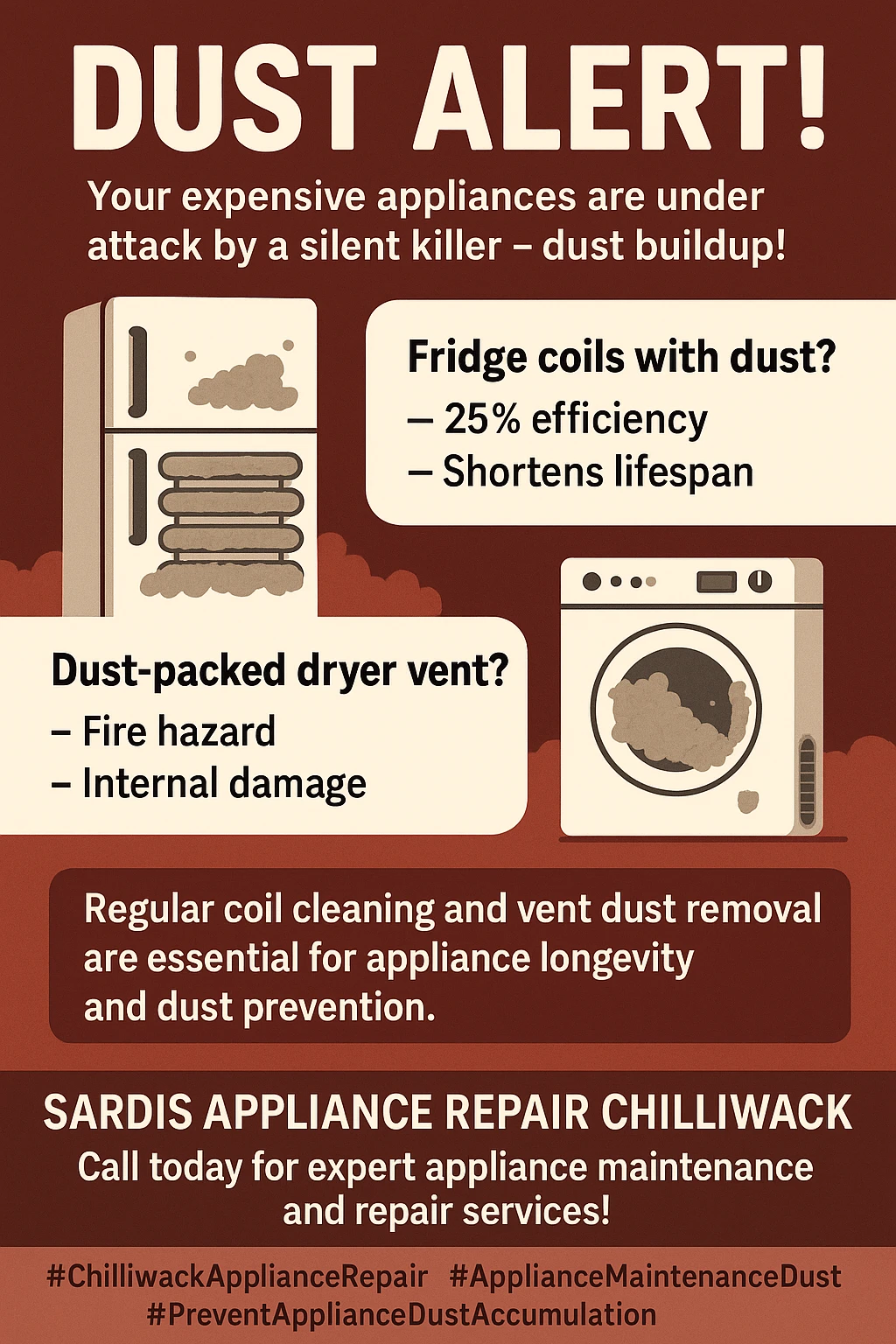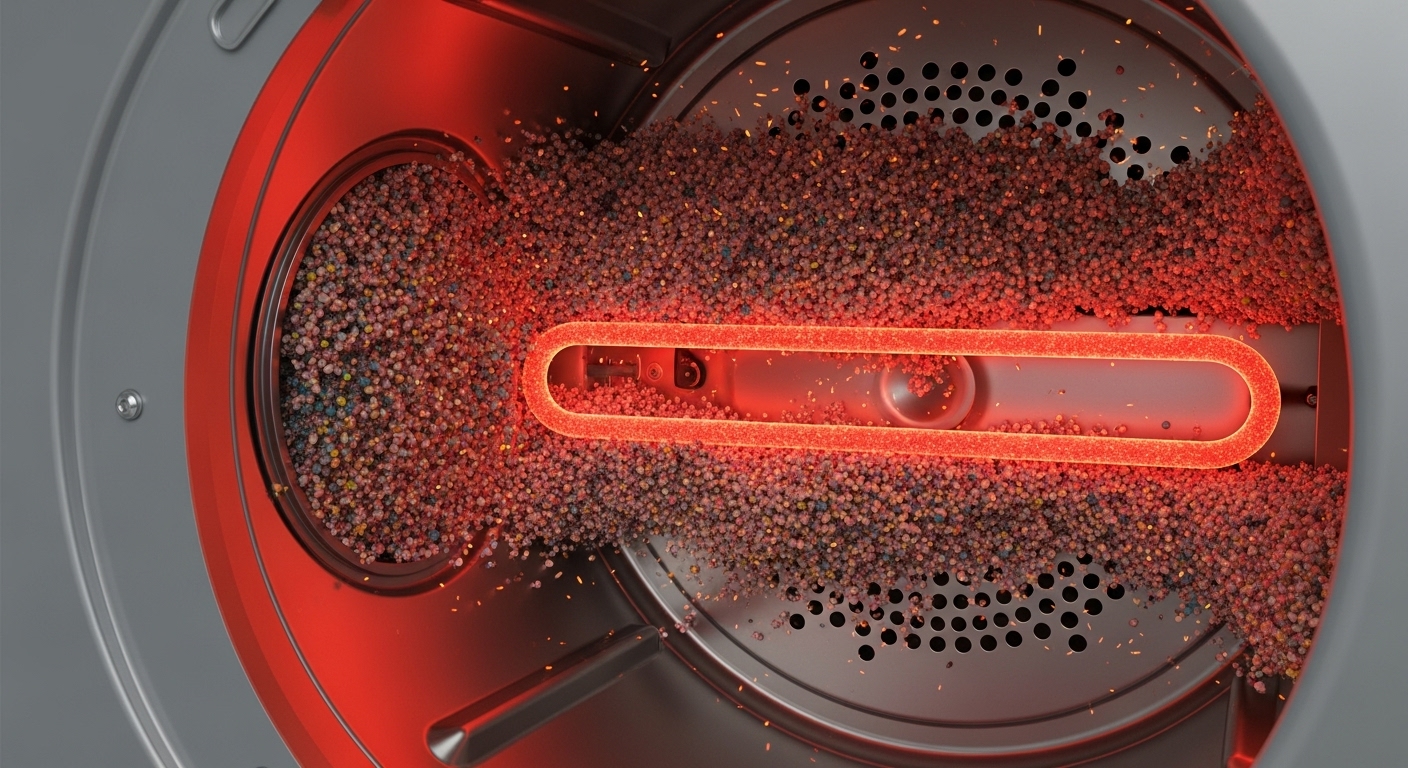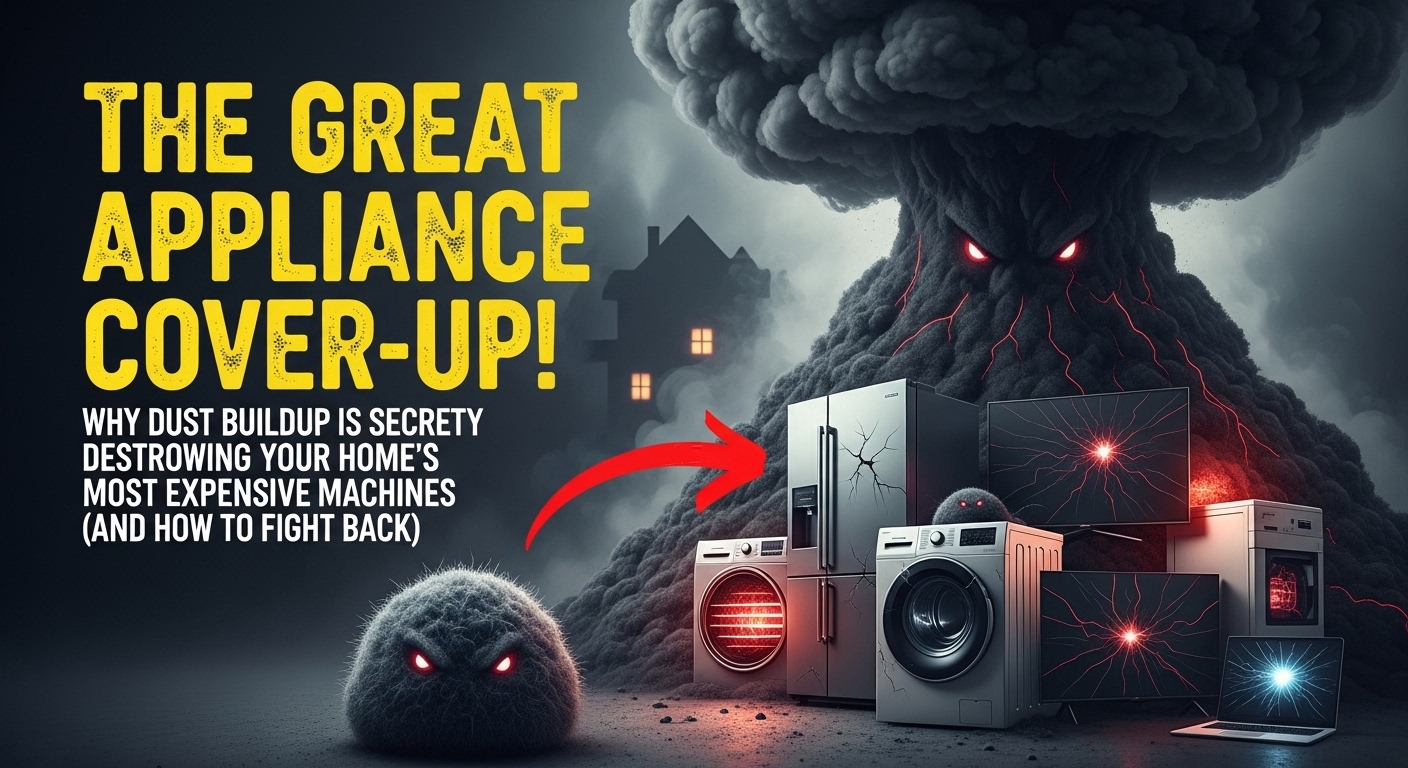The Great Appliance Cover-Up: Why Dust Buildup Is Secretly Destroying Your Home’s Most Expensive Machines (And How to Fight Back)
Wondering why your energy bills keep climbing while your appliances seem to break down faster than ever? The culprit might be hiding in plain sight – dust accumulation is silently wreaking havoc on your home’s most expensive machines, costing Chilliwack homeowners hundreds of dollars in wasted energy and premature replacements.
Picture this: you’re standing in your kitchen, staring at a refrigerator that’s running constantly, making strange noises, and somehow managing to let your groceries spoil faster than usual. Meanwhile, your dryer takes forever to finish a load, your range hood sounds like a freight train, and that mysterious burning smell keeps wafting from behind your appliances. What you’re experiencing isn’t just normal wear and tear – it’s the devastating effects of dust buildup that most homeowners never see coming. 
Here’s the thing that’ll really get your attention: dirty refrigerator coils alone can spike your energy usage by up to 35%, while lint accumulation causes approximately 15,500 dryer fires every single year across North America. That innocent-looking layer of dust isn’t just making your appliances look grimy – it’s creating a perfect storm of inefficiency, overheating, and potential disaster that’s costing you serious money. The good news? Once you understand how this silent destroyer operates, you can fight back with strategies that’ll save your appliances, slash your utility bills, and give you peace of mind.
Living in the Fraser Valley means dealing with unique dust challenges that most cleaning guides don’t address. Between agricultural particles drifting in from surrounding farmland, seasonal pollen invasions, and the moisture fluctuations that come with BC’s unpredictable weather patterns, your appliances are under constant assault from airborne contaminants that can clog, corrode, and catastrophically damage expensive components.
Key Outtakes:
- Dust buildup can increase appliance energy consumption by up to 35% while shortening lifespan significantly
- Lint accumulation causes approximately 15,500 fires annually, with dryers being particularly vulnerable to dust-related failures
- Professional cleaning services in Chilliwack can prevent costly repairs and extend appliance life by years
- Simple preventative measures like appliance covers and regular maintenance schedules dramatically reduce dust-related damage
- Smart home integration and seasonal cleaning routines provide advanced protection against BC’s unique dust challenges

The Hidden Economics of Appliance Dust Damage
Before we dive into the nitty-gritty of dust prevention, let’s talk money – because the financial impact of neglecting dust buildup will absolutely shock you. Most Chilliwack homeowners have no idea they’re literally throwing cash out the window every month thanks to dust-clogged appliances working overtime just to maintain basic functionality.
When dust accumulates on your refrigerator’s condenser coils, something scary happens behind the scenes. According to appliance efficiency experts, dirty refrigerator coils can increase energy usage by up to 35%, forcing your compressor to work exponentially harder just to keep your food cold. Think about that for a second – more than one-third of your refrigerator’s energy consumption could be completely wasted on fighting dust buildup that you can’t even see. For the average Chilliwack household spending around $150 monthly on electricity, that’s potentially $50+ disappearing into thin air every single month. 
But energy waste is just the tip of the iceberg. An overworked compressor due to clogged coils becomes prone to catastrophic failure, and we’re talking about repair bills that can easily hit $800-1200 or complete replacement costs exceeding $2000 for a decent refrigerator. The cruel irony? Routine coil cleaning costs maybe $20 in supplies and an hour of your time, but skipping this simple maintenance can lead to premature appliance death that’ll devastate your household budget.
The fire risk component adds an entirely different dimension to the economic equation. According to the U.S. Consumer Product Safety Commission, there are an estimated annual 15,500 fires, 10 deaths and 10 injuries due to clothes dryer fires, with lint accumulation being the leading cause. Beyond the obviously tragic human cost, house fires create insurance nightmares, displacement expenses, and property losses that can easily reach six figures. When you realize that most dryer fires are completely preventable through proper lint management, the economics become crystal clear.
Here’s where it gets really interesting from an insurance perspective – and this is something most homeowners never consider. Many appliance warranties explicitly require proper maintenance, and insurance adjusters are increasingly sophisticated about identifying neglect-related failures. If your house burns down because of a lint-clogged dryer vent, or your refrigerator compressor dies from dust-induced overheating, you might discover that your coverage doesn’t extend to damage caused by “failure to maintain.” That’s a potentially devastating loophole that could leave you personally responsible for massive repair and replacement costs.
The warranty voiding issue extends beyond just fire damage. Modern appliances contain sophisticated sensors and electronic components that are extremely sensitive to dust contamination. When these components fail due to overheating or electrical interference caused by dust buildup, manufacturers can legitimately argue that inadequate maintenance voided the warranty terms. Given that high-end appliances now routinely cost $3000-5000 each, losing warranty protection over a $30 cleaning service becomes an incredibly expensive oversight.
Appliance-Specific Dust Vulnerabilities and Consequences
Now that we’ve established the financial stakes, let’s get specific about how dust attacks different types of appliances throughout your home. Each machine has unique vulnerabilities, and understanding these weak points helps you prioritize your prevention efforts for maximum protection and cost savings.
Your refrigerator represents ground zero in the battle against dust damage. Those condenser coils we mentioned earlier are typically located either on the back panel or underneath the unit, making them invisible during normal use but incredibly vulnerable to dust accumulation. When coated in dust, debris, and the inevitable pet hair that seems to migrate everywhere, they hinder performance and spike energy usage as the compressor must work harder and longer to maintain the desired internal temperature. The warning signs are usually subtle at first – the refrigerator runs constantly, you notice unexplained increases in electricity bills, or food starts spoiling quicker than normal.
But here’s what most people don’t realize: dust doesn’t just affect the coils. It infiltrates the interior components, clogging drain tubes and interfering with temperature sensors that regulate cooling cycles. When these sensors get confused by dust buildup, your refrigerator starts making erratic decisions about when to run the compressor, leading to temperature fluctuations that can spoil expensive groceries while simultaneously wasting energy. The combination of food loss and energy waste creates a double financial hit that compounds monthly until you address the root cause. 
Dryers present perhaps the most dangerous dust-related vulnerabilities in your home. Lint accumulation creates what fire safety experts describe as a perfect storm of combustible conditions. Lint is essentially concentrated cotton fibers mixed with synthetic materials from your clothing, creating highly combustible material that accumulates not just in the obvious lint trap, but throughout the internal ductwork, around heating elements, and in exhaust vents. The scary part? Most of this dangerous buildup happens in areas you never see during normal operation.
Professional dryer vent cleaning services report finding truly shocking amounts of lint in residential systems – sometimes enough to fill multiple garbage bags from a single cleaning session. This accumulation doesn’t just create fire risks; it destroys drying efficiency by restricting airflow and forcing your dryer to run longer cycles at higher temperatures. The result? Increased energy costs, accelerated wear on clothing, and heating elements that burn out prematurely from overwork. Many homeowners find themselves replacing expensive dryer components every few years without realizing that simple lint management could have prevented the failures entirely.
Electronic components in modern appliances face unique dust-related challenges that older mechanical systems never encountered. Today’s smart refrigerators, Wi-Fi enabled washers, and computerized ovens contain sophisticated circuit boards that generate heat during operation. Dust accumulation acts as an insulator around these components, …
 (604) 305-2992
(604) 305-2992 
 Schedule An Appointment
Schedule An Appointment 
